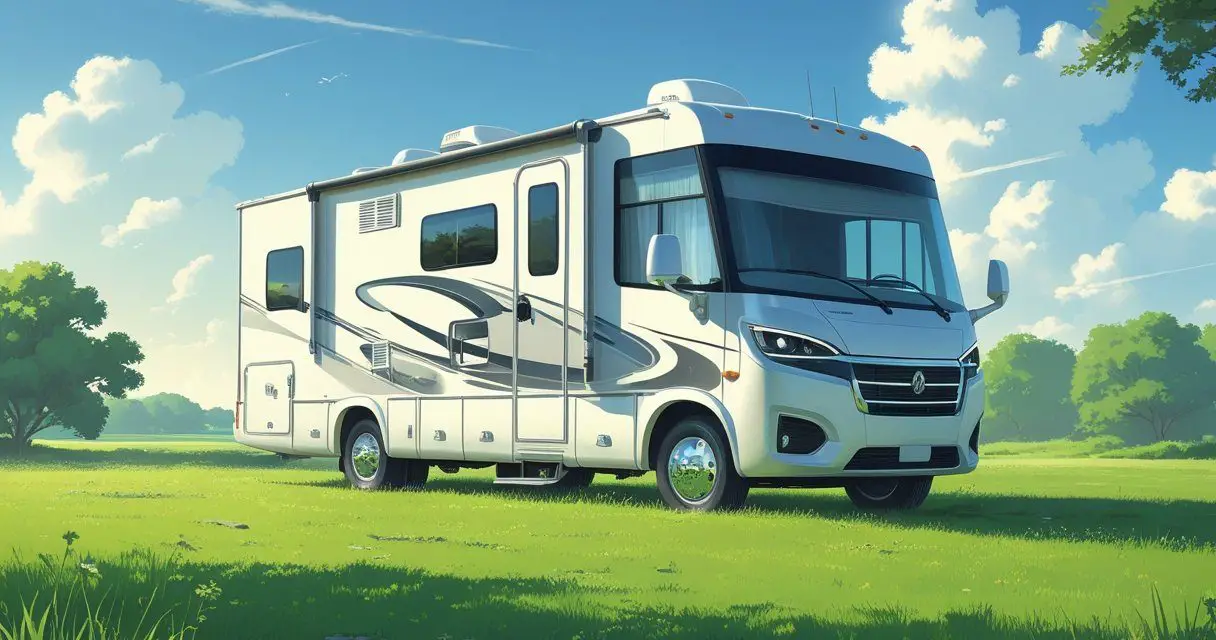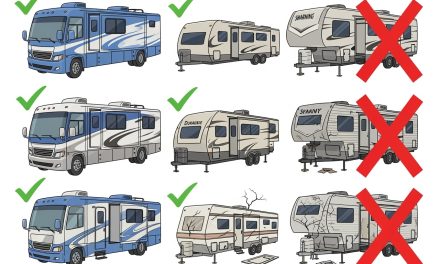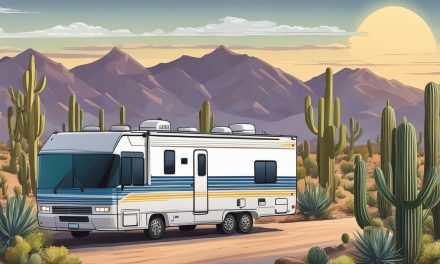Would you like to save this article?
Traveling in an RV gives you freedom and flexibility, but that doesn’t mean you can stop anywhere you want. You can’t legally park your RV just anywhere, but with the right knowledge, you can find plenty of safe and legal places to stay overnight.
Understanding where you can and can’t park helps you avoid fines, safety issues, and unwanted knocks on your door in the middle of the night.
You’ll find that parking rules change from one city or state to another. Some rest areas, retail parking lots, and public lands welcome overnight stays, while others limit or ban them.
Knowing how to spot legal options and plan ahead makes your trip smoother and more enjoyable.
Learning the basics of RV parking laws, using helpful apps, and following good parking etiquette will keep your travels stress-free and respectful to local communities.
Key Takeaways
- RV parking rules vary by location and property type.
- Planning ahead helps you find safe, legal overnight spots.
- Responsible parking keeps travel easy and stress-free.
Understanding RV Parking Laws and Restrictions
RV parking rules differ depending on where you stop. You must know how federal, state, and local laws interact, what rights you have on private property, and what penalties apply if you park in restricted areas.
These details help you avoid fines, towing, or legal issues when traveling or living in your RV.
Federal, State, and Local Regulations
There are no broad federal laws that allow overnight RV parking anywhere in the country. Federal lands, such as those managed by the Bureau of Land Management (BLM) or the U.S. Forest Service, often permit temporary stays, but each site has its own limits—usually 14 days within a 28-day period.
At the state level, rules vary widely. Some states, like Minnesota, allow short overnight stays at rest areas, while others, like Colorado, prohibit camping or sleeping in vehicles at rest stops.
Always check the state’s Department of Transportation website before stopping.
Local governments add another layer of regulation. Cities and counties often restrict RV parking on residential streets or require permits for overnight stays.
For example, some California cities issue Temporary Overnight RV Permits, while others ban street parking entirely.
| Level | Example Authority | Common Rule Type |
|---|---|---|
| Federal | BLM, National Forests | Time limits on dispersed camping |
| State | DOT or Highway Patrol | Rest area stay limits |
| Local | City or County Ordinances | Street parking restrictions or permits |
Private Property Rules
Parking on private property is generally allowed if you have the owner’s permission. However, zoning laws and Homeowners Association (HOA) rules can limit how long or where you may park.
Some HOAs ban visible RVs or require storage behind fences or in garages.
If you rent or own property, check your local zoning code. Many cities restrict RV parking in driveways or front yards, especially if the vehicle exceeds a certain length or blocks sidewalks.
When staying overnight at businesses like big-box stores or casinos, always ask management first. Some chains permit RV parking as a courtesy, but local ordinances can override store policies.
A quick phone call can save you from a ticket or tow.
Penalties for Illegal Parking
Violating RV parking laws can lead to fines, towing, or impound fees. Penalties depend on the jurisdiction but often start around $50–$250 per violation.
In some cities, repeat offenses may increase the fine or result in vehicle removal.
If your RV is towed, you may also pay storage fees until it’s retrieved. These costs can add up quickly, especially in urban areas.
You can usually appeal a citation through local traffic or municipal courts. Keep any permits, receipts, or photos that prove compliance.
Staying informed and following posted signs remains the best way to avoid penalties while traveling.
Where You Can Legally Park an RV
You can park your RV in many places, but the rules depend on location and property ownership. Local ordinances, business policies, and permit requirements decide whether overnight parking is allowed or restricted.
Public Streets and Residential Areas
Most cities limit how long you can park an RV on public streets. Common limits range from 24 to 72 hours, and signs often show exact time restrictions.
Some areas ban oversized vehicles in residential zones or require special parking permits.
Sleeping in your RV on a public street is usually illegal. Many local laws forbid using a vehicle as a dwelling or for “camping” on public roads.
Even if your RV is parked legally, staying overnight can result in a citation.
If you want to park near your home, check your city’s municipal code or zoning ordinances. Rules may cover driveway parking, setback distances, and surface requirements.
Homeowners’ associations (HOAs) may have stricter limits, such as allowing RVs only for short loading or unloading periods.
Commercial Parking Lots and Businesses
Private businesses control whether RVs can park on their property. Some large stores—like Walmart, Cracker Barrel, or Cabela’s—sometimes allow overnight parking as a courtesy, not a right.
Always ask a manager before staying, since local laws may still prohibit overnight use.
Even when allowed, keep your stay short and respectful. Avoid setting up chairs, grills, or slides.
Park away from main entrances and leave the area clean. Store managers can ask you to leave at any time.
Hotels may let guests park RVs while staying in a room. If you are not a registered guest, most hotels will not allow it.
Truck stops and travel centers often permit short rest breaks but not long-term parking or camping.
Permit-Required Locations
Some public lands and rest areas allow RV parking with limits or permits. State and national parks offer designated campsites that require reservations and fees.
These sites often include hookups, dump stations, and stay limits of 14 days.
Bureau of Land Management (BLM) and national forest lands allow dispersed camping, usually free but limited to 14 days in one spot. You must move at least 25 miles before setting up again.
Follow posted rules about waste disposal and fire safety.
Highway rest areas are meant for short stops. Some states allow up to 8–10 hours, while others ban overnight parking.
Always check posted signs or state transportation websites before staying.
RV Parking on Public Lands
You can legally park your RV on certain public lands managed by federal or state agencies, but each area has its own rules. Time limits, permits, and location restrictions often apply, and enforcement is strict to protect natural resources and public safety.
Bureau of Land Management (BLM) Land
BLM land offers some of the most flexible options for dispersed camping. You can usually stay up to 14 days within a 28-day period in one location.
After that, you must move at least 25 miles to a new site.
You don’t need a reservation for most BLM areas, but some regions may require a free or low-cost permit. Always check local field office websites for maps, fire restrictions, and seasonal closures.
Camping rules often include keeping your RV 200 feet from water sources, using existing clearings, and packing out all waste.
Many BLM sites lack hookups, water, or restrooms, so you must be self-contained.
| Rule | Typical Requirement |
|---|---|
| Stay Limit | 14 days per 28-day period |
| Distance Between Sites | 25 miles |
| Water Distance | 200 feet minimum |
| Permit | Sometimes required |
National Parks and Forests
In national parks, you must stay in designated campgrounds. Reservations are often needed, and sites may have length limits for large RVs.
Overnight parking outside these campgrounds is not allowed.
National forests provide more flexibility through dispersed camping. You can often camp outside developed areas for free, but you must follow local stay limits—usually 14 days—and avoid blocking roads or damaging vegetation.
Some forest districts require a campfire permit or restrict generator use to certain hours. You should check the official website of the specific forest or park before arriving.
Tip: Carry cash or a credit card for campground fees, as some remote areas lack electronic payment systems.
Rest Areas and Highway Stops
Rest areas are meant for short breaks, not overnight camping. Most states allow you to park and rest for 8 to 10 hours, but sleeping in your RV beyond that can lead to fines.
Signs at each rest area list the time limits and rules. Some states, like Texas and Montana, are more lenient, while others strictly enforce no-overnight policies.
You should avoid setting up chairs, grills, or slides, as this may be viewed as camping. Use rest areas for quick stops, driver rest, or temporary safety breaks before moving on to a legal camping location.
Options for Overnight RV Parking
You have several legal and safe choices for overnight RV parking, depending on your budget, travel style, and location. Some offer full hookups and amenities, while others provide simple places to rest without cost or services.
RV Parks and Campgrounds
RV parks and campgrounds are the most reliable places to stay overnight. They usually provide electric, water, and sewer hookups, along with restrooms, showers, and laundry facilities.
You’ll also find Wi‑Fi, picnic tables, and sometimes pools or recreation areas.
Most campgrounds charge a nightly fee that ranges from $25 to $75, depending on the location and amenities. Public campgrounds in state or national parks often cost less but may require reservations during busy seasons.
You can stay longer at these sites, which makes them ideal for extended trips. Rules are usually clear—quiet hours, pet policies, and check‑out times are posted.
If you prefer convenience, security, and community, RV parks and campgrounds give you predictable comfort.
Boondocking and Dispersed Camping
Boondocking means camping without hookups, often on public lands managed by the Bureau of Land Management (BLM) or the U.S. Forest Service. These areas allow dispersed camping outside developed campgrounds, usually for free or with a small permit.
You must be self‑sufficient. Bring enough water, manage waste properly, and follow Leave No Trace principles.
Stay limits usually range from 7 to 14 days.
Boondocking offers quiet, space, and scenic views far from crowded parks. However, you need to plan for road access, weather, and safety.
Many RVers use apps or maps to locate legal sites. This option suits travelers who value independence and don’t need hookups every night.
Truck Stops and Alternative Locations
Truck stops like Flying J, Pilot, and Love’s provide overnight parking for RVs. They offer fuel, food, restrooms, and sometimes showers or dump stations.
Expect noise from trucks, but the lighting and activity make them safer than isolated areas.
Other alternatives include Walmart, Cracker Barrel, and Cabela’s parking lots, where some locations allow RVs to park overnight with permission.
Always ask the manager or check local rules before staying.
Casinos, churches, and rest areas can also be options, though policies vary. These spots work best for quick overnight stops when you need convenience and accessibility more than quiet or scenery.
Finding Legal RV Parking: Tools and Resources
You can use mobile apps and websites to locate legal, safe, and convenient RV parking. These tools help you check regulations, read user reviews, and compare options such as public lands, rest areas, and commercial campgrounds.
Campendium
Campendium provides a large database of campgrounds, RV parks, and free camping areas across the United States. You can filter results by price, hookups, cell coverage, or location type.
Each listing includes user reviews, photos, and GPS coordinates to help you confirm accessibility and conditions before arriving. The platform often lists Bureau of Land Management (BLM) and National Forest sites, making it useful for dispersed camping.
Campendium also highlights overnight parking limits and road conditions to help you avoid restricted or unsafe areas. You can access it through a free website or a mobile app, with optional premium features that remove ads and expand search filters.
iOverlander
iOverlander focuses on community-driven data. Travelers upload and update information about legal overnight parking, dump stations, water fills, and mechanic services.
You can view entries on an interactive map that works offline, which is valuable when traveling in remote areas without cell service. Each site includes notes on safety, cost, and local restrictions.
Because the database is user-managed, you should verify details before relying on them.
AllStays
AllStays offers detailed information on RV parks, rest areas, truck stops, Walmart parking, and campgrounds. You can use filters to find places with hookups, dump stations, or height restrictions.
The app also shows state and local parking rules to help you avoid fines or towing. Many users rely on it for overnight parking at commercial locations, since it notes which stores or lots allow RV stays.
AllStays is a paid app, but it includes frequent updates and verified listings, making it reliable for planning long trips.
Best Practices and Responsible RV Parking
Responsible RV parking means protecting the environment, following local rules, and keeping good relationships with the places you visit. You help preserve natural areas and maintain access for future travelers when you act with care and awareness.
Leave No Trace Principles
You should follow Leave No Trace principles every time you park or camp. These guidelines help reduce your impact on the land and wildlife.
Always pack out all trash, including food scraps, and use designated dump stations for waste and gray water. Avoid creating new campsites or driving off established roads.
Parking only in durable areas, such as gravel or pavement, prevents soil erosion and damage to vegetation. If you use a generator, keep noise levels low and avoid running it late at night.
When camping on public land, follow posted stay limits—often 14 days per site—and move to a new area afterward. Respect fire restrictions, use existing fire rings, and fully extinguish fires before leaving.
A quick checklist can help:
| Action | Purpose |
|---|---|
| Pack out trash | Prevent litter and protect wildlife |
| Use dump stations | Avoid water contamination |
| Stay on durable surfaces | Protect soil and plants |
| Follow stay limits | Reduce site overuse |
Respecting Local Communities
When parking near towns or neighborhoods, you represent the RV community as a whole. Always follow local ordinances on overnight parking and avoid blocking driveways, sidewalks, or business entrances.
Ask permission before staying on private property, even if it looks empty. Many stores or parking lots allow short stays, but policies vary by location and local law.
A quick conversation with a manager can prevent misunderstandings. Keep noise down, manage pets responsibly, and avoid running generators early or late.
Support local businesses by buying fuel, groceries, or meals nearby. If signs prohibit overnight parking, move to a legal campground or public land area.





